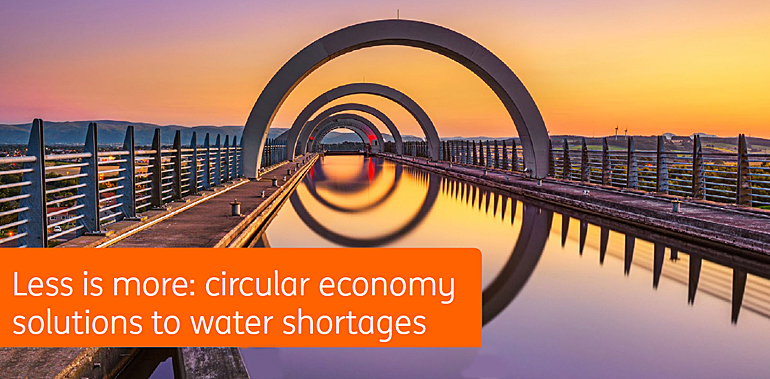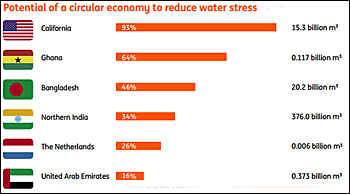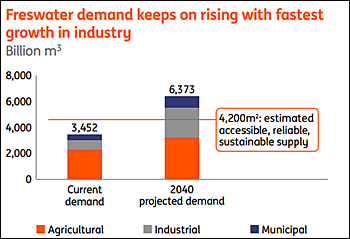Circular economy can almost fully undo water stress in California

If Californian water users close the water loop and make their water systems regenerative, 12 billion cubic meter of water can be saved annually. This would reduce the water stress in this US state by more than 90 percent.
This emerges from the Dutch retail bank ING report Less is more: Circular solutions to water shortages, for which the research institute Deltares supplied the datasets.
The report focuses on the effects of a circular economy on the water stress in six regions around the world. Potentially these regions can save 400 billion cubic meter of water yearly, equivalent to 11 percent of global water demand and almost the entire water consumption in the US.
 Source: ING calculations based on Deltares modelling
Source: ING calculations based on Deltares modelling
Reduction of water stress
The water savings by the introduction of multiple cycles cannot fully compensate for the expected water shortages, the study concludes.
Up to 2050 California is expected to experience water shortages in 30 out of the 34 years. According to the studies, the circular economy has the potential to reduce this considerably to 13 years.
The report shows that more circular water systems can improve the local balance of water supply and demand in all six regions (Northern India, California, Ghana, United Arab Emirates, Bangladesh and the Netherlands).
New business opportunities
Gerben Hieminga, ING Economics Department: “Applying the principals of the circular economy requires transformative change of current linear water systems, which in turn also presents businesses with a range of opportunities throughout the supply chain.”
“Nonetheless, we must be aware of the fact that these measures cannot be implemented in isolation,” says Hieminga. “Barriers to progress, such as costs of implementation, regulatory control and free water rights, as well as the entire water cycle from supply, demand and behaviour, needs to be improved before a circular water solution can be as effective in achieving such positive results.”
 If no changes are made, global water demand is forecasted to outpace the sustainable water supply in 2040 by 35% (source: ING – Too Little Too Much, 2015, based on IFPRI and Aquastat)
If no changes are made, global water demand is forecasted to outpace the sustainable water supply in 2040 by 35% (source: ING – Too Little Too Much, 2015, based on IFPRI and Aquastat)
Global water model
Deltares looked at how measures based on the circular economy can impact the efficient use and recycling of water in agriculture, industry and households.
The global water model Water2Invest was used to calculate the potential effect of these measures on water scarcity in six countries.
This model was developed by Deltares in collaboration with, among others, consultancy firm Future Water and Utrecht University.
To calculate the potential of a circular economy in California, the following water measures were identified:
• maintain water quality in ground water resources.
• behavioural change and water efficient technologies introduced by industries and households.
• apply water efficient irrigation techniques and increase the use of water efficient crops as well as drought tolerant crops.
• water retention through aquifer storage and rain water harvesting coupled with water transfer possibilities between storage facilities.
• re-use of grey water by businesses and households
This news item was originally published on the websites of Deltares and ING.
Read also on this website
● Deltares' Aqua Monitor reveals remarkable changes in global land and water surface, 25 August 2016
● Deltares officially opens big data iD-Lab to assess and visualize global water issues, 29 March 2016
● Climate change will hit energy-related water use in multiple ways, 8 December 2015
More information
Deltares
Delft, the Netherlands
+31 88 335 8273
www.deltares.nl
ING Wholesale Banking
Amsterdam, the Netherlands
+31 20 563 9111
www.ingwb.com



